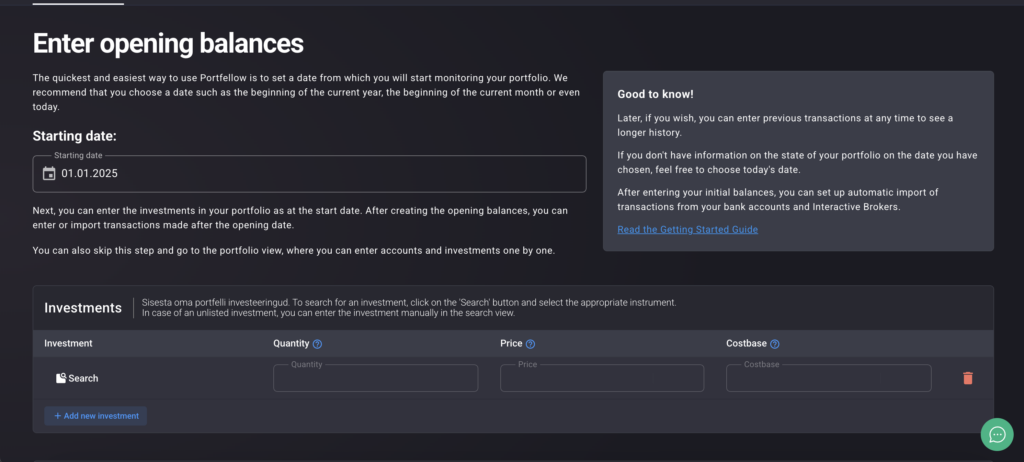New! Go through the entire process with us! Watch the video here!
Creating a Portfolio
Once you have opened your Portfellow account, the first step is to create a portfolio.
To do this, click on “Create a New Portfolio”. A window will open where you can enter the portfolio name, currency, ownership type, and choose the performance annualization method.
If you invest both as an individual and through a legal entity, we recommend creating separate portfolios for tracking each. Later, you can generate a consolidated portfolio view that combines data from selected portfolios (e.g., a consolidated view of investments from both your personal and asset management company accounts).
Example:
Portfolio Name: Marco Polo
Currency: EUR
Ownership: Individual
Annualization Method: Compound Annual Growth Rate (CAGR)
or
Portfolio Name: Marco Holding Company OÜ
Currency: EUR
Ownership: Company
Annualization Method: Compound Annual Growth Rate (CAGR)
Algsaldode sisestamine
Entering Initial Balances
Once the portfolio is created, you will be redirected to the initial balances entry page.
The quickest and easiest way to start using Portfellow is to set a date from which you want to track your portfolio.
This can be today’s date or a date in the past (ideally within the last 90 days).
Why choose a start date within the last 90 days?
Portfellow integrates with banks, and these integrations retrieve transactions up to 90 days back.
As a best practice, we recommend setting the start date as the last day of the previous quarter:
If today is November 1st, set the start date as September 30th.
If today is June 1st, set the start date as March 31st.
Why not start from years ago?
You can always add historical transactions later to track a longer history.
It’s easier to get started—you get a clear view of your current portfolio.

Entering Initial Balances – Investments
The first step is to enter your investments. Here, you can input all the instruments included in your portfolio.
For non-listed investments, you can manually enter them in the search view.
For publicly traded instruments, click “Search” and select the appropriate instrument. Then fill in the remaining required fields.

Entering Initial Balances – Cash / Accounts
The second step is to enter brokerage and bank accounts.
- Add all bank accounts associated with this portfolio (personal or company accounts).
- Add all brokers where you hold accounts (e.g., Interactive Brokers, Lightyear, Kraken, etc.).
- If you invest via crowdfunding platforms, add your crowdfunding account (for tracking idle cash in the platform).
- If an account holds multiple currencies, you can add each currency separately.

Reviewing Your Portfolio
Once you have entered and saved your investments and accounts, you will be redirected to the Portfolio page.
Here, you can view an overview of your portfolio, including all entered investments and cash accounts.
You can also visit each instrument to update details in the detailed view.
In the top right corner, you’ll find the “Add New” button, which allows you to enter new investments and accounts.

Bank and Broker Integrations (Paid Plan Feature)
On the “Accounts” page, you will see all your entered bank and brokerage accounts.
With a paid plan, you can set up automatic integrations with financial institutions to automatically import transaction data.
Click “Add Integration” to open instructions on how to link a specific account.

Successfully Set Up Your Portfolio—What’s Next?
Now that you’ve entered one portfolio, you can proceed to enter the next portfolio (e.g., a company investment account).
Additionally, you can start adding historical transactions to build a longer investment history.
Happy portfolio tracking and smart investing! 🚀